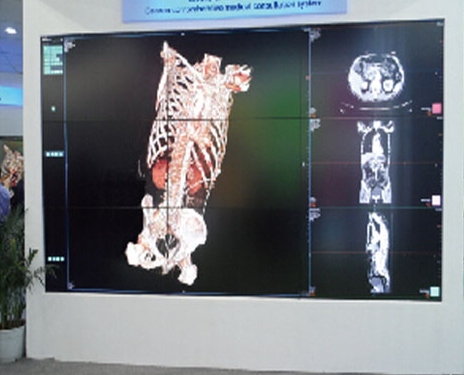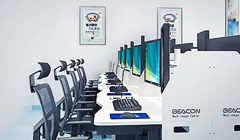Problems Needing Attention When Purchasing Medical Display
As more and more hospitals begin to build PACS systems and set up digital soft-reading workstations, as the data stream terminal in the system, the performance of the medical diagnostic-level LCD will directly affect the quality of the diagnosis, and the diagnostic-level Displays also account for a relatively high proportion of the cost of PACS, so the selection of medical displays has also attracted much attention


What are the basic issues that should be paid attention to when choosing medical diagnostic LCD
1. Is the monitor fully automatic DICOM calibration in real time?
In medical imaging, whether it is observed on the monitor of a workstation or on a light box with film, all digital images must maintain visual consistency. This is a very key word. If there is no standard for these graphics in different equipment If the above display is standardized, the display effect on another device may be completely different, and the diagnostic value will be greatly reduced
The fourteenth chapter of the DICONM standard is the grayscale standard display function. This function specifies how to associate the pixel value with the displayed brightness value. It is required that every image carrier: monitors, films, and photos meet this standard, so that doctors can see exactly the same images on different carriers at different times, in different places, and on different carriers.
For medical displays, it is necessary to use a luminance meter and software to measure and calibrate the luminance to make it comply with DICOM GSDF Requirements.
The DICOM calibration methods of the display include manual calibration with external luminance meter and automatic calibration with built-in luminance meter. Manual calibration requires manual operation by the user to measure several or all 256 grayscale points of the display one by one, which requires full-time personnel to spend a lot of time and the calibration result is not very accurate. The automatic calibration completely avoids these problems. The display has accurately measured each gray level in the factory. The built-in brightness meter monitors the current brightness at any time and displays it in real time. After installation, it can run completely in the background without manual intervention. Improve accuracy and eliminate tedious procedures such as testing and maintenance
2. How accurate is the DICOM calibration of the monitor
The compliance degree of DICOM calibration is the prerequisite to ensure accurate diagnosis by doctors. The DICOM3.14 standard defines two indicators, FIT and LUM, to evaluate the degree of compliance of the display with the DICOM GSDF grayscale standard display function curve. The LUM index indicates the degree of dispersion between each gray scale point and the standard function curve, expressed by the root mean square error. The closer the LUM value is to zero, the more the gray scale curve displayed by the display overlaps the standard curve, that is, the greater the error. small. Manually calibrated displays must be calibrated and measured each time before they can understand the error between the current display and the standard curve. However, the control software equipped with the automatically calibrated monitor can monitor and feed back the current LUM value in real time to determine the accuracy of the monitor’s calibration.
Therefore, whether to automatically calibrate and display the LUM value in a timely and accurate manner has become an important criterion for evaluating medical diagnostic-level displays. Generally speaking, in terms of process efficiency, if the calibration preparation time of the display system exceeds 45 minutes, the process needs to be simplified. As an important parameter of DICOM calibration accuracy, the _LUM value can enable doctors to have an intuitive and clear understanding of the accuracy of calibration. Therefore, the real-time display of the LUM value realized by the software function can greatly improve the reliability of the calibration, thereby ensuring the quality of the diagnosis.
3. Whether the brightness of the display can be adjusted arbitrarily
Different doctors have different requirements for the brightness of the display. There is a non-linear relationship between the human eye's ability to distinguish gray scales and brightness. The higher the maximum brightness is set, the greater the brightness difference between each gray scale, and the easier it is for human eyes to distinguish. Therefore, some doctors require setting at a higher brightness in order to obtain the maximum contrast. However, some doctors require the setting to be set at a higher brightness to protect eyesight and avoid eye discomfort after prolonged use. Therefore, there will be a variety of requirements for the brightness setting of the display, which requires the display to be quickly set to the required brightness and automatically perform DICOM calibration
Due to the limitation of the DICOM calibration method design, the display calibrated with an external brightness meter can only be fixed at the set brightness after calibration. If the brightness needs to be adjusted, it must be recalibrated. Select the current brightness to display in real time. The built-in luminance meter with adjustable brightness can automatically calibrate the display to meet the requirements of each doctor and ensure the quality of diagnosis.
4. Whether it has network remote centralized monitoring
When the scale of PACS is small, the equipment maintenance personnel can check each monitor regularly and maintain each monitor regularly. However, after the development of a larger PACS network system, the daily inspection and maintenance of each display will become a time-consuming and laborious task due to the wide distribution of displays, and on-site testing will even disrupt the diagnosis of doctors. This requires that the display can be equipped with software for centralized network monitoring.
The remote management software of the monitor can use the existing PACS network, use the simple network management protocol, and remotely automatically test each workstation to centrally monitor and manage all the monitors on the PACS network, adjust the brightness remotely, modify the management password, etc., Originally, these are all tasks that need to be carried out on site.
The display needs to be equipped with network remote centralized monitoring software to improve work efficiency and ensure the work quality of the display. This is especially important for hospitals with large-scale imaging network systems.
5. The degree of after-sales service and technical support
Understanding after-sales service and technical support is another key consideration. It is necessary to evaluate the technical support capabilities of sellers and manufacturers and the life-long maintenance of the equipment, and make sure that the manufacturer can guarantee the long-term stable after-sales support of the display.
The failure of the display will seriously affect the stable operation of the PACS system. Only dealers who choose high-quality brands, and have long-term insurance and quick after-sales service response can quickly repair them in the event of a failure. Some manufacturers can provide the service of overnight replacement of the monitor, which shortens the response time for fault repair and greatly improves the quality of after-sales service


 Diagnostic Display
Diagnostic Display






 Home >
Home >  Back to list
Back to list


